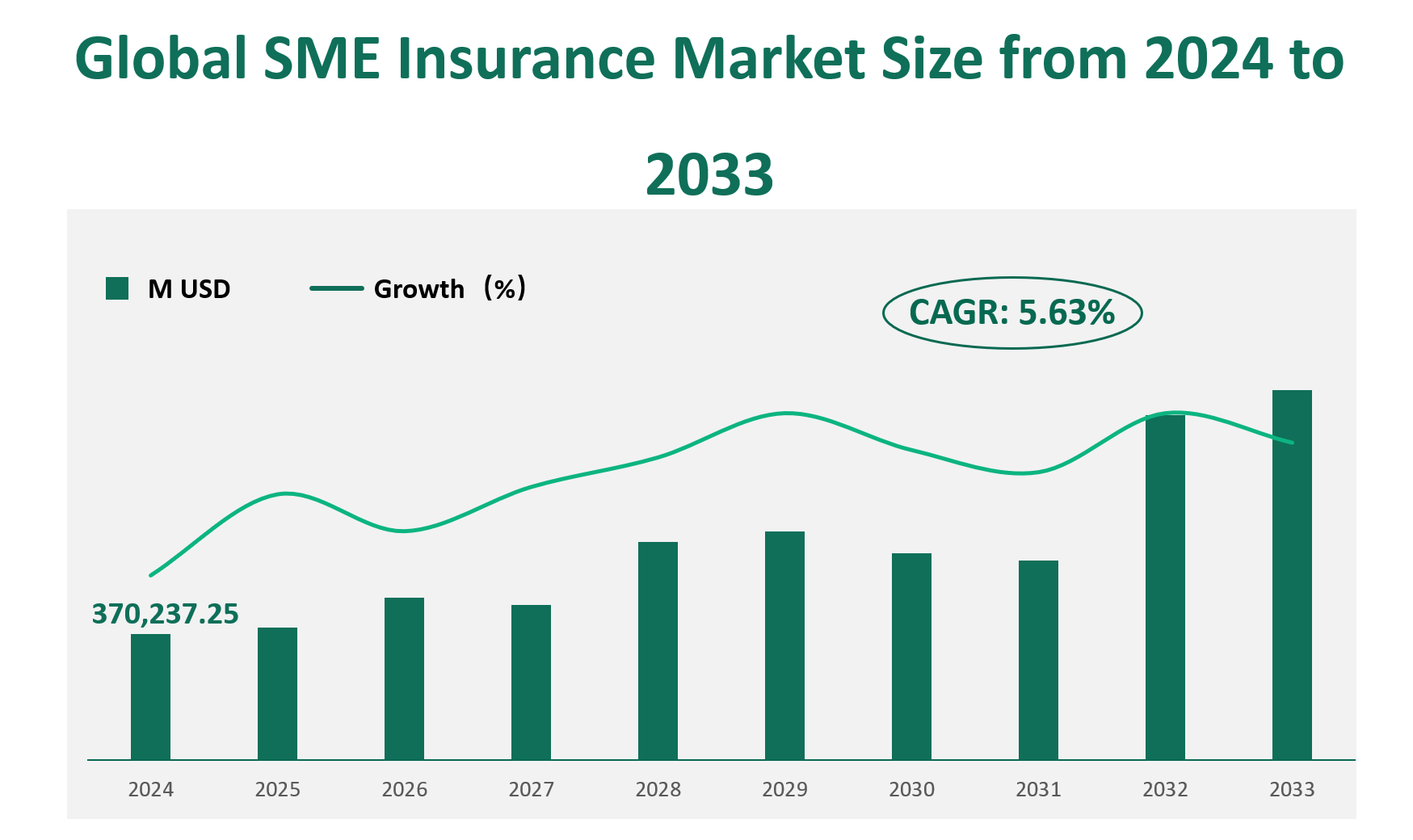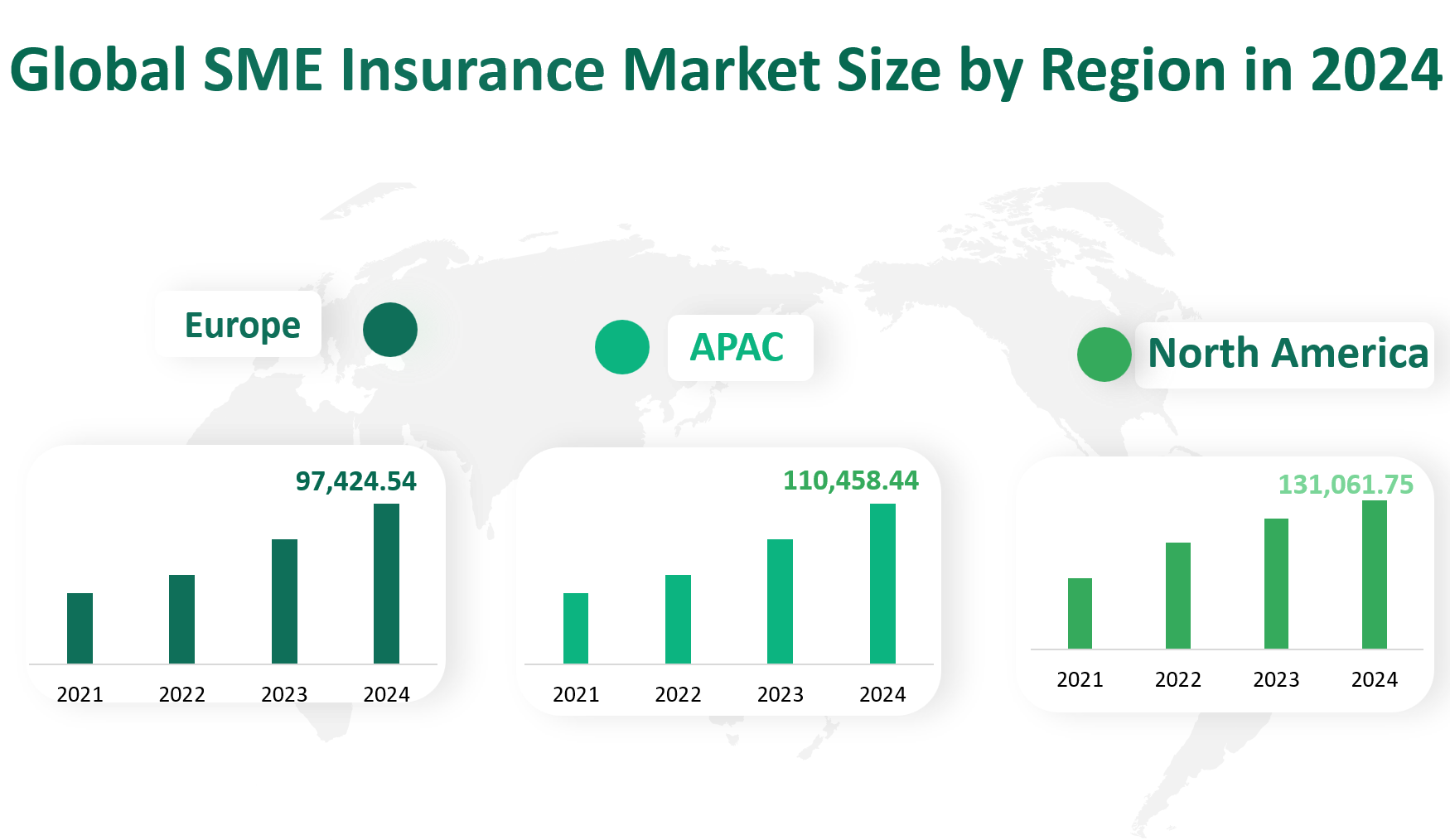1. Global SME Insurance Market Insight Analysis
The global SME Insurance Market is projected to reach a value of $370,237.25 million USD in 2024, with a Compound Annual Growth Rate (CAGR) of approximately 5.63% from 2024 to 2033.
SME Insurance refers to the specialized insurance products designed to cater to the unique needs of small and medium-sized enterprises. These enterprises, which typically employ between 1 and 249 employees, face a variety of risks, including property damage, liability issues, and business interruptions. SME Insurance helps mitigate these risks by providing financial coverage for potential losses.
Figure Global SME Insurance Market Size (M USD) and CAGR (2024-2033)

2. Driving and Limiting Factors of SME Insurance Market Growth
Economic Stability: A stable economy encourages SMEs to invest in insurance to protect against potential losses.
Regulatory Support: Governments around the world are implementing policies that support SMEs, including insurance regulations that make it easier for these businesses to obtain coverage.
Technological Advancements: The adoption of digital technologies has made insurance products more accessible and affordable for SMEs.
Increasing Awareness: There is a growing awareness among SMEs about the importance of risk management and the benefits of insurance.
Economic Uncertainty: Economic downturns can lead to reduced spending on insurance as SMEs prioritize immediate financial needs.
Complex Regulatory Environment: Navigating complex insurance regulations can be challenging for SMEs, potentially deterring some from purchasing coverage.
High Costs: The cost of insurance can be prohibitive for some SMEs, especially those with limited budgets.
Cybersecurity Threats: The increasing frequency of cyber attacks poses a significant risk to SMEs, but the cost of cybersecurity insurance can be a barrier.
3. Technology Innovation and Corporate Mergers and Acquisitions in SME Insurance Market
Technology has become a cornerstone of innovation in the SME insurance market. The adoption of advanced technologies such as artificial intelligence (AI), machine learning, and big data analytics is enabling insurers to offer more personalized and efficient services. For instance, AI-driven algorithms can analyze vast amounts of data to predict risk more accurately, allowing for more tailored insurance products. Machine learning models can also automate claims processing, reducing the time and cost involved in handling claims.
Moreover, the rise of digital platforms and mobile applications is making it easier for SMEs to access and manage their insurance policies. These platforms provide real-time updates, policy management tools, and instant access to customer support, enhancing the overall customer experience. The integration of the Internet of Things (IoT) devices is another notable trend. IoT sensors can collect data on various aspects of business operations, such as equipment performance and environmental conditions, which can be used to provide more precise risk assessments and preventive maintenance recommendations.
4. Global SME Insurance Market Size by Type
The SME Insurance market is segmented into various product types, each designed to cater to the specific needs of small and medium-sized enterprises (SMEs). These product types include insurance for non-employing businesses, businesses with 1-9 employees, 10-49 employees, and 50-249 employees.
This type of insurance is designed for sole proprietors or single-person businesses that do not have employees. These businesses still require insurance to protect against property damage, liability claims, and other risks. In 2024, the market value for this segment is projected to be $57,254.19 million USD.
This category covers SMEs with a small workforce, typically between 1 and 9 employees. These businesses require more comprehensive coverage to protect against employee-related risks, such as workers’ compensation, liability, and health insurance. The market value for this segment in 2024 is forecasted to be $73,656.29 million USD.
SMEs with 10 to 49 employees often have more complex operations and require more extensive insurance coverage. This includes property and casualty insurance, liability insurance, and group health insurance. The market value for this segment in 2024 is expected to be $95,728.71 million USD.
This category includes larger SMEs with a significant workforce, ranging from 50 to 249 employees. These businesses require comprehensive and customizable insurance solutions to address their diverse needs. The market value for this segment in 2024 is projected to be $143,598.06 million USD.
Table Global SME Insurance Market Size by Type in 2024
Market Size (M USD) 2024 | Market Share | |
Insurance for Non-employing | 57254.19 | 15.46% |
Insurance for 1-9 Employees | 73656.29 | 19.89% |
Insurance for 10-49 Employees | 95728.71 | 25.86% |
Insurance for 50-249 Employees | 143598.06 | 38.79% |
5. Global SME Insurance Market Size by Application
The SME Insurance market is also segmented by various applications, which refer to the different channels through which insurance products are distributed and sold. These applications include agency, broker, bancassurance, and direct writing.
Agencies are intermediaries that represent multiple insurance companies and offer a wide range of products to SMEs. They provide personalized service and advice, helping SMEs choose the most suitable insurance products. In 2024, the market value for the agency application is projected to be $48,482.93 million USD.
Brokers are similar to agents but often have more extensive networks and access to a broader range of insurance products. They negotiate on behalf of SMEs to secure the best terms and coverage. The market value for the broker application in 2024 is forecasted to be $150,422.61 million USD.
Bancassurance involves the sale of insurance products through banking channels. This application leverages the existing customer base and trust of banks to offer insurance products. In 2024, the market value for bancassurance is expected to be $38,260.19 million USD.
Direct writing refers to the sale of insurance products directly by the insurance company to SMEs, without intermediaries. This application allows for more control over the sales process and customer relationships. The market value for direct writing in 2024 is projected to be $133,071.52 million USD.
Table Global SME Insurance Market Size by Application in 2024
Application | Market Size (M USD) 2024 | Market Share |
Agency | 48482.93 | 13.10% |
Broker | 150422.61 | 40.63% |
Bancassurance | 38260.19 | 10.33% |
Direct Writing | 133071.52 | 35.94% |
6. Global SME Insurance Market by Top Regions
North America is expected to hold a substantial share of the SME Insurance market in 2024, with a forecasted value of $131,061.75 million USD. The region’s market is characterized by a mature insurance industry, high adoption rates of advanced technologies, and strong regulatory frameworks.
Europe is anticipated to be the largest regional market by revenue in 2024, with a forecasted value of $97,424.54 million USD. The region’s market is influenced by stringent regulations and a high level of insurance penetration. The growth rate in Europe is expected to be 6.60% from 2024 to 2033, driven by the need for SMEs to comply with regulatory requirements and manage risks effectively.
The Asia-Pacific region is projected to be the fastest-growing region in the SME Insurance market, with a forecasted value of $110,458.44 million USD in 2024. The region’s market is driven by rapid economic growth, increasing SME participation, and rising awareness of insurance benefits. The growth rate in Asia-Pacific is expected to be 5.46% from 2024 to 2033, making it a key area for market expansion.
The Middle East & Africa region is expected to have a market value of $14,315.47 million USD in 2024. The region’s market is influenced by economic diversification efforts and increasing SME activity.
South America is forecasted to have a market value of $16,977.06 million USD in 2024. The region’s market is characterized by growing SME participation and increasing insurance demand.
Figure Global SME Insurance Market Size by Region in 2024

7. Global SME Insurance Market Analysis by Major Players
7.1 AXA:
Introduction and Business Overview: AXA is a French multinational insurance firm established in 1816. The company offers a wide range of insurance products, including property and casualty, life insurance, and investment management services.
Products: AXA provides SMEs with comprehensive coverage options, such as inpatient plans, group discounts, and coverage for pre-existing medical conditions.
7.2 Allianz:
Introduction and Business Overview: Allianz Global Corporate & Specialty (AGCS) is a corporate insurance carrier and a key business unit of Allianz Group. Established in 2006, the company provides risk consultancy, property-casualty insurance solutions, and alternative risk transfer.
Products: Allianz offers casualty insurance, HPR insurance, program & facility SME risk consulting, and other specialized insurance products.
7.3 Zurich:
Introduction and Business Overview: Zurich Insurance Group is a multi-line insurer established in 1872. The company operates in over 215 countries and territories, offering property and casualty, and life insurance products and services.
Products: Zurich provides commercial combined insurance, cyber executive risk solutions, professional indemnity, property owners insurance, and other specialized products.
7.4 AIG:
Introduction and Business Overview: American International Group (AIG) is an American multinational finance and insurance corporation established in 1919. The company operates in over 80 countries and jurisdictions.
Products: AIG offers a wide range of insurance products, including property all risks, commercial guard, fire, burglary, and liability insurance.
7.5 Munich Re:
Introduction and Business Overview: Munich Re Group is a reinsurance company based in Munich, Germany, established in 1880. The company provides specialty coverage solutions, reputational risk covers, and liability solutions.
Products: Munich Re offers general liability, workers’ compensation, employers’ liability, excess casualty, and umbrella insurance.

